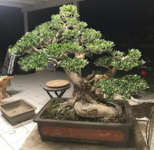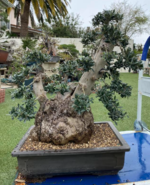You are using an out of date browser. It may not display this or other websites correctly.
You should upgrade or use an alternative browser.
You should upgrade or use an alternative browser.
Does anybody have pictures of burl style bonsai they can share?
- Thread starter electraus
- Start date
electraus
Mame
Really interesting. Do you know whether the exact site of trauma to the original tree is always where the cambial overproduction happens or can it happen anywhere on the tree? I believe Bob told me that this particular burl was from a tree that was cut down. If I’m remembering correctly, he said the burl itself was completely buried underground.Aesthetic reasons. A group of trees will be a bit more convincing without emphasizing the hump of a burl. Halfway under the soil will minimize it a bit. Burls are indeed alive, at least most of the time. They arise from injury or infection, ect. They are a center of cambium/xylem overproduction-cambium is the living tissue just underneath the bark which is the living portion of the trunk.

The Mystery of Tree Burls
The exact mechanism that causes burl formation is not fully understood.extension.unh.edu
Also, do you know if a burl always forms when a tree sustains significant trauma? I can’t remember who on here it was that did this, but I read a thread where someone experimented with shooting the trunks of 7 or 8 trees they had growing in the ground to see if they would form burls and all but one (if not all) formed burls. @Maiden69, might be something woodworkers looking for burls should consider looking into
Maiden69
Masterpiece
electraus
Mame
Right. Pretty incredible work for a tree you’ve only had for a year. I would’ve guessed you had this tree for at least 2-3 years. Then again, it helps that there was quite a lot of growth to work with and that redwoods grow like weeds. Amazing tree nonetheless!It’s a redwood. I do have a picture of it when I purchased it last fall.
View attachment 509852
electraus
Mame
Perhaps if you use a big enough gunGood luck trying to achieve this by by shooting the trunks of trees...
Redwood tree.
View attachment 509861
ABCarve
Masterpiece
I really wouldn’t call this a burl. I’ve had a number of years but it started out as what most people would call a clump. Most of the larger trunks were cut off and only the smaller one were allowed to develop. There are a lot of large wounds still healing on this.Thanks! This is extremely helpful. As I’ve already mentioned to others, I thought the burl itself was all deadwood. Had absolutely no idea that it could sprout new suckers. Thank you for sharing this pic. Do you have any pics of when you first acquired it?
FreshAirSunshine
Shohin
Depends on how much of the burl is alive. It’s quite large relative to the current tree but I could see a few interesting approaches depending on the extent of living tissue for the Burl. If it’s mostly dead I’d treat it almost like a root-over-rock design and maybe carve the burl. If it’s alive, I think a clump or even almost forest-like design could be cool, once again treating the Burl almost as a “hill” from which a “grove” of trees can be growing.I’m mostly seeing burls styled in a multi trunk or forest style. Just out of curiosity: if this tree was yours, would you style it as a single trunk informal upright or a clump/multi trunk? Also, how would I go about finding the live vein on the burl? It’s not quite as easy to discern as that of a collected juniper
Cadillactaste
Neagari Gal
Gosh.. I'm brain, dead tired. I'm like...I do!?! ...I hope i'm remembering the right person... but i think @Cadillactaste had some along this line


ZombieNick
Shohin
I always thought it would be cool to make a burl bonsai, I see I am far from the first. How did you go about sourcing material like this? Did it cost an arm and a leg?
Stunning example of a clump style bonsai, and my new inspiration for a small leaf olive clump I recently picked up.Here is an olive with a fat base in more of forest style.
Post in thread 'The Legacy and Culture of Bonsai Provenance: Exploring the Roots and Significance of Iconic Trees'
https://www.bonsainut.com/threads/t...gnificance-of-iconic-trees.61251/post-1063289
ABCarve
Masterpiece
Cadillactaste
Neagari Gal
Look into turtleback styles as well. Where the base is similar to what you've got going on.Hello everyone,
A friend and I challenged each other to design a tree in a style we have never worked with before. I chose a (very normal and common) cascade style juniper or pine for him meanwhile he chose a burl style for me Before this, I didn’t even know what a burl style was and in all honesty I still don’t have the best understanding. I reached out to Bob shimon asking if he had anything like this available and he showed me this coast live oak.
I have no idea how to proceed with this monstrosity and I can’t find inspiration pics online. I wired the “trunk” of the tree to better position it in relation to the Burl but quickly realized I have absolutely no idea what I’m doing. What is next step of the process with this tree? Do I need to let the trunk thicken to become more proportional to the Burl? I have no clue what this tree is even supposed to look like when finished. Any help/inspiration pics would be greatly appreciated. Thanks in advance!
I might do a drop branch on that right side...take foliage down along the burl side. Really quick , rough edit. Sorry.
That said...if it back buds and you could create a clump or mini Grove. Could be cool. I personally would try and make it the illusion of part of the trunk once fully developed. Get that foliage close to it. And ramification...
Words to chew over only. Always see your vision. Never another's.

Last edited:
GSCarlson
Shohin
electraus
Mame
Ok I see why I should bury the burl a bit now. I’m seeing most burls styled as clumps/forests. Can I ask what considerations went into deciding to style this one as a single trunk vs multi trunk? I’m also seeing that the trunks on most burls, be it single or multi, emanate from the top side of the Burl, whereas on mine, it emanates from the basal area on the back of the burl. More than anything I guess I’m having trouble choosing a design direction and would appreciate input on what you would do if it was yours.My live oak has a significant burl at ground level. It is living and sometimes pushes shoots. The burl is in the front right of the base
electraus
Mame
I bought it from Bob Shimon at Mendocino Coast Bonsai (mcbonsai.com). He collects coast redwoods, junipers, Mendocino pygmy cypresses, and live oaks. In all honesty, I couldn’t recommend Bob enough. He has some absolutely incredible pieces of material at very reasonable prices. I buy all of my collected material from him. This one was about $250 if I remember correctly.I always thought it would be cool to make a burl bonsai, I see I am far from the first. How did you go about sourcing material like this? Did it cost an arm and a leg?
Stunning example of a clump style bonsai, and my new inspiration for a small leaf olive clump I recently picked up.
electraus
Mame
This was along the lines of my original thoughts on what to do with it. I’m not sure if it’s a big/wide enough burl to house multi trunks. Plus the fact that the trunk is coming from the back of the base of the burl makes me think it may be better off as a single trunk now that I’ve seen pictures of both.Look into turtleback styles as well. Where the base is similar to what you've got going on.
I might do a drop branch on that right side...take foliage down along the burl side. Really quick , rough edit. Sorry.
That said...if it back buds and you could create a clump or mini Grove. Could be cool. I personally would try and make it the illusion of part of the trunk once fully developed. Get that foliage close to it. And ramification...
Words to chew over only. Always see your vision. Never another's.
View attachment 509879
Just so I’m understanding correctly, you’re suggesting I grow the trunk girth a bit more and position the trunk and style the tree to look as if it had a turtleback style base, correct? I like this idea!
gfreak
Mame
I went back through the posts, yea i was thinking of this post https://www.bonsainut.com/threads/l...ut-hershey-kiss-trunk-based-in-the-usa.61193/Gosh.. I'm brain, dead tired. I'm like...I do!?! ...possibly my Bog Monster you are thinking of?
View attachment 509873 View attachment 509872
Didn't remember you were asking about that style, just had a vague memory of your name with the post lol.
that bog monster IS great though
Cadillactaste
Neagari Gal
Ahhhh yeah, my friends tree in that image there. He is responsible for my purchase of the Olive pig I now own. Lol... but...many called the smaller olive a burl...among other less kind names.I went back through the posts, yea i was thinking of this post https://www.bonsainut.com/threads/l...ut-hershey-kiss-trunk-based-in-the-usa.61193/
Didn't remember you were asking about that style, just had a vague memory of your name with the post lol.
that bog monster IS great though
Thanks...I sort of like the Bog Monster.
Maiden69
Masterpiece
Bigleaf or hard maple? Looks like hard maple (a.saccharum), bigleaf creates big lumps, but hard maple creates very nice tight burls.Maple burl I've been watching for 40 years. It's about 30' from the ground. There are no branches emerging from it.
View attachment 509877
Cadillactaste
Neagari Gal
I can see it as one tree. Yes...turtleback style is what came to mind...This was along the lines of my original thoughts on what to do with it. I’m not sure if it’s a big/wide enough burl to house multi trunks. Plus the fact that the trunk is coming from the back of the base of the burl makes me think it may be better off as a single trunk now that I’ve seen pictures of both.
Just so I’m understanding correctly, you’re suggesting I grow the trunk girth a bit more and position the trunk and style the tree to look as if it had a turtleback style base, correct? I like this idea!
ABCarve
Masterpiece
Hard maple, don’t have any of that bigleaf growin’ round here.Bigleaf or hard maple? Looks like hard maple (a.saccharum), bigleaf creates big lumps, but hard maple creates very nice tight burls.
Similar threads
- Replies
- 7
- Views
- 1K
- Replies
- 13
- Views
- 3K
- Replies
- 17
- Views
- 5K







